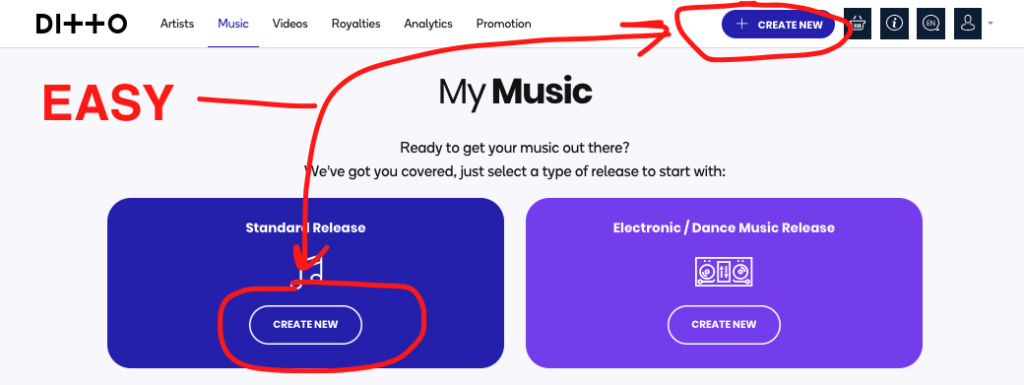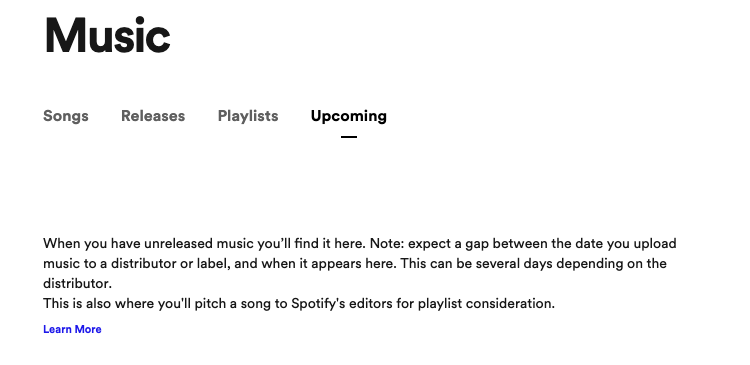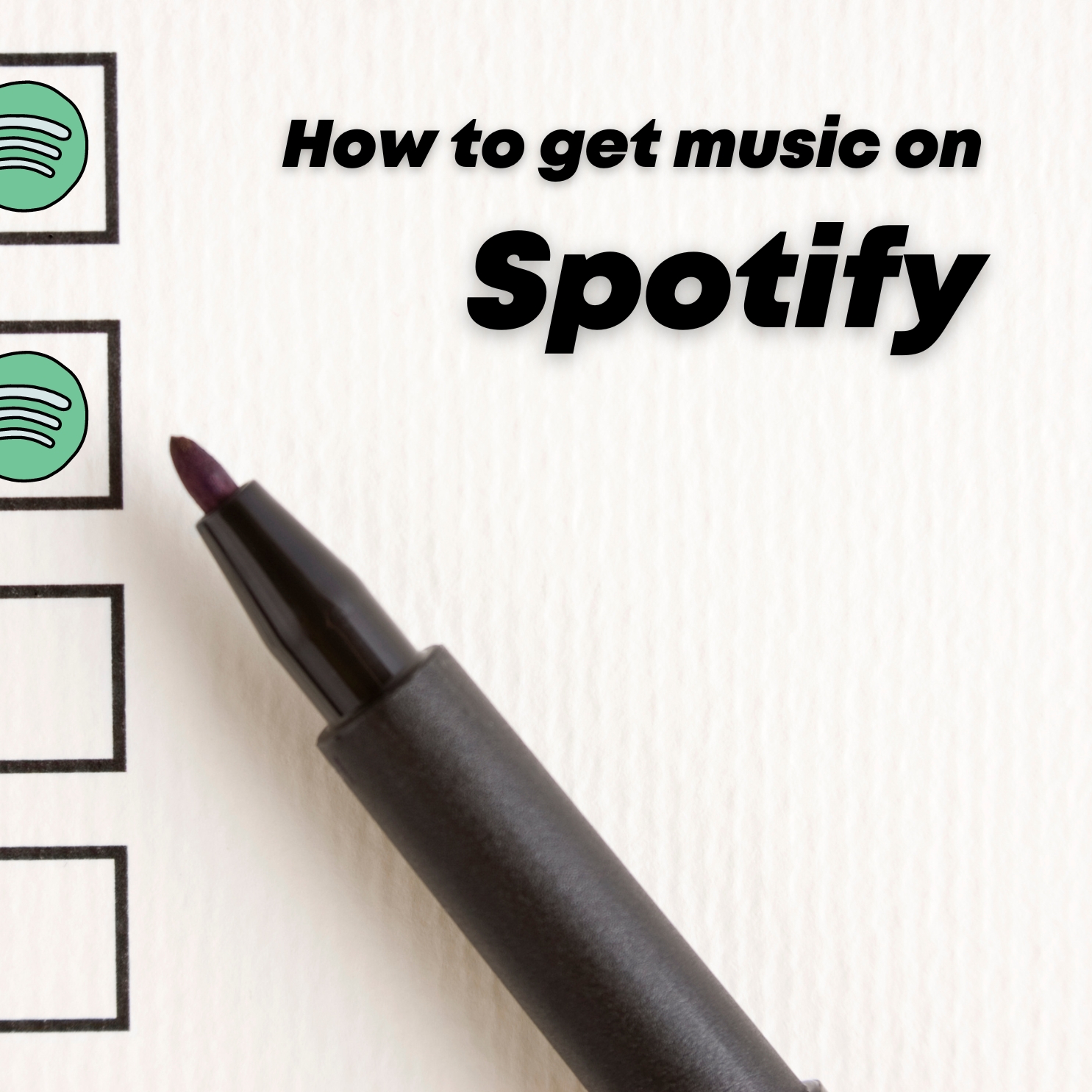Good news: In 2023, it’s pretty easy to get music onto Spotify.
Here’s what you have to do to make it happen:
- Sign up with a music distribution service.
- Upload your track to the distribution service (typically as a high-definition .wav file).
- Fill out meta data (i.e., the name of the song, production credits, and so on).
- Schedule your release date (usually at least three weeks in advance).
- Celebrate the fact that you’ve put music out into the world.
That’s pretty much it.
But in case you’re not convinced (or are still slightly confused), I’ll spend the rest of this article covering those steps in more depth, with the end goal being that you’ve got a full handle on putting music onto the world’s best streaming service.
Let’s do it.
Step 1: Pick a music distributor.
It used to be that back in the day, if you wanted to get a song onto Spotify, you had to lug a backpack full of CDs to Spotify’s headquarters – walking uphill both ways to Stockholm, Sweden – sneak past the guards, then drop your songs one by one into a hidden mailbox slot and hope for the best. Oftentimes, you didn’t hear back. Sometimes, you perished on the journey.
Just kidding. It was never that hard. But these days, it’s easier than ever, thanks to the proliferation of modern music distribution services.
Music distributors do, more or less, what their name implies: They distribute music to different stores (most of which are online, like Spotify, Apple Music, and Amazon Music). Picking a distribution service is the first step toward getting your music onto Spotify.
The biggest indie music distribution services at the moment are:
And there are plenty others, too – here’s a fuller list of music distributors we’ve put together that reviews the options in more detail, and here’s Spotify’s list of preferred providers.
Most of these will run you in the neighborhood of $10-$20 total per year, although some (like CD Baby) charge per song, and some (like Amuse) are free upfront.
I’d generally recommend going with a service that doesn’t charge per song, especially if you’re planning to release music consistently (which you probably should). It’s also worth checking to see if a service will take any of your streaming revenue; DistroKid, TuneCore, and Ditto don’t, but some, like CD Baby, will take a cut.
Overall, though, my recommendation is not to waste too much time deliberating on different options. Just pick one and go with it. For most artists, any one of DistroKid, TuneCore, or Ditto will get the job done just fine. They’re all pretty comparable.
Step 2: Upload your music to your distributor.
Once you’ve signed up for a music distributor, the next step toward getting your onto Spotify is to upload your music to the distribution service. This is as simple as clicking the big “Upload” button in your distribution service. Here’s what that looks like in DistroKid:

And it’s similarly easy in other platforms. For example, here’s Ditto:

From there, you’ll move through a wizard that prompts you to fill out your musical meta data.
“But wait, what format should my file be in to upload music to Spotify?”
Ah, good question.
Most distributors prefer a 24-bit, 44.1 kHz .wav file, but there’s some wiggle room. Here are DistroKid’s guidelines, for example, where they recommend 16-bit, 44.1 kHz .wav, and here are TuneCore’s where they stress that the file should be 24-bit.
I’d go with whatever your mastering engineer likes (and, as a fallback, whatever your distributor recommends).
Step 3: Fill out meta data for your music via your distributor.
Once you’ve got your song in the queue, you’ll be prompted by your distributor to fill out an array of meta data.
This includes information like:
- Artist or band name
- Song name(s)
- Songwriting credits
- Production credits
- Explicit lyrics
- The language of the lyrics
And so on.
Here’s what the meta data page looks like in DistroKid:

Looks a little complicated, but it’s really pretty straightforward to fill out.
Step 4: Schedule out your release date.
This is technically included as part of the data-filing process, but I’m breaking it out because it’s important: As you prepare to put your music on Spotify, you’ll typically be asked to pick a release date (unless you’re going with some super cheap distributor that doesn’t support this functionality, in which case you should probably switch to a different distributor).
At the very least, you should schedule the release date for three weeks in advance – and I’d probably opt for a month, just to be safe.
Scheduling your song this far out will give your distributor time to get it to streaming service providers (like Spotify) and will give you time to pitch your song to editorial playlists through the Spotify for Artists submission tool. Most often, you’ll get rejected, which just means you won’t hear back. But if you happen to get an editorial placement, it’s a big win, and you’ll probably see a significant bump in streams. There’s no reason not to at least try.
Also, scheduling things out in advance gives you time to go back and forth with your distributor if you run into any issues. Better to have some buffer time than to be scrambling to fix some naming issue two days before release.
Step 5: Celebrate the fact that you’ve put music into the world.
After you’ve scheduled you song for release, I legitimately think you should celebrate.
Because it’s an awesome accomplishment to make music, and because, personally, I find that hard to acknowledge, especially at the end of the song creation process when I’m sick and tired of what I’ve made and I just want to move onto the next thing.
Don’t belittle this. Get yourself a strong margarita, a bag of your favorite light roast coffee, or whatever floats your boat, and toast the time and effort it’s taken to put your art into the world.
Then celebrate again when the music actually comes out. Your music matters. In all seriousness, that’s important to remember.
Commonly asked questions about putting music on Spotify
All right, the above five steps are the process for putting music onto Spotify – but I recognize you might still have a few questions about the process.
Here are a few answers to common inquiries.
Why should I put music on Spotify?
The simple answer is that Spotify is the most popular music streaming platform in the world, with more than 500 million users (according to the company’s latest data).
So, if you want your music to be heard, Spotify offers the biggest platform.
I’d also argue that it’s one of the friendliest platforms for creators. Sure, Spotify has its issues, but it also works pretty hard to support artists, and it provides a lot of tools to help with audience building (whereas Apple Music, for example, provides next to nothing).
How long will it take my music to appear on Spotify after I send it to my distributor?
It varies by distributor, but usually it takes two days to two weeks before a song you submit to your distributor shows up in your Spotify for Artists portal (under “Upcoming” in the “Music” section).

DistroKid boasts that they have the fastest distribution times, and I’ve seen that to be generally true; usually it only takes a couple of days from the time you submit to Distrokid to the time you see your release. Most often, it seems like others – including CD Baby, TuneCore, and Ditto – take about a week.
(This is why it’s important to set a release date several weeks in advance.)
How do I get verified on Spotify?
You have to claim your artist profile via the Spotify for Artists portal. Here’s Spotify’s quick video on how to do it:
If you already have music out on Spotify, this process is really easy. If you haven’t released anything yet, you can still claim your profile and get verified before your song is out, but you do have to have a song submitted for release.
Here’s a helpful article from Andrew Southworth on how to pre-claim your profile before your first release.
How much will Spotify pay me per stream?
Not much. Sorry.
It varies depending on a range of factors (notably including the geographic dispersion of your streams), but on average, you can expect to receive between $0.003 and $0.005 per stream from Spotify.
We’ve got a full article on this here if you want to dig into the discouraging data. The overall takeaway is that you’re not going to make much from streaming, especially if you’re just starting out. That’s why it’s important to create income in other ways if you want music to become a sustainable career.
Final thoughts on getting music onto Spotify
So, I’ve covered the step-by-step process to get music onto Spotify. The last thing I want to do in this article is take a step back and note this:
It’s pretty incredible that you can put music into the world this easily.
I can vividly remember the first time I uploaded a song to Spotify. It felt like a miracle, seeing my band’s name pop up in the search box, on the same platform where I listened to my favorite artists.
I’d thought, growing up, that the barrier to making and releasing music into the world was so high – and, truthfully, back in the day, it kind of was. You had to have connections or at least expensive studio equipment to create something that sounded decent and to have someone besides your mom listening.
Today, it’s easy.
That’s a gift. It’s worth remembering, and I hope it spurs you on to create more music.
All right, philosophical stuff aside, that’s about all I’ve got.
I hope this little guide has been helpful in getting your music onto the world’s most popular streaming platform, and here’s wishing you good luck.
You’ve got this.








